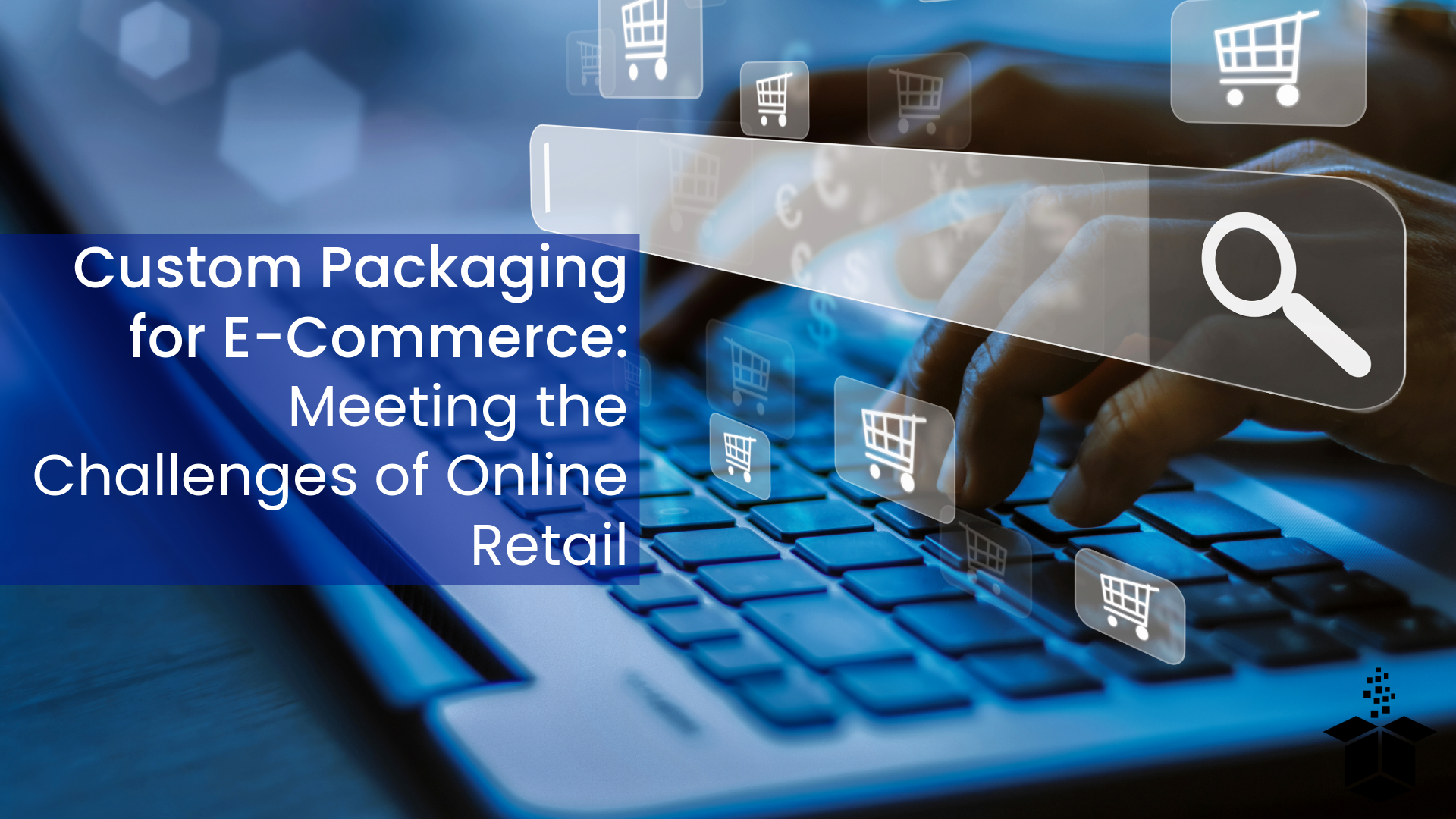Custom Packaging for E-Commerce: Meeting the Challenges of Online Retail
With the e-commerce world constantly growing, packaging plays a crucial role in determining customer satisfaction, brand perception, and operational efficiency. As online shopping continues to thrive, e-commerce businesses face distinct packaging challenges that extend beyond aesthetics. Custom packaging must address the demands of secure delivery, offer a memorable unboxing experience, and align with growing consumer expectations for sustainability. This blog will explore the unique needs of e-commerce businesses, focusing on durability, the unboxing experience, and sustainability, while offering practical solutions to common packaging challenges.
Why E-Commerce Packaging is Different from Traditional Retail
Unlike traditional retail, where packaging only needs to be attractive on a shelf, e-commerce packaging must survive multiple touchpoints, from warehouses to distribution centers and, finally, the consumer’s doorstep. In this journey, packaging serves not only as a protective barrier but also as a key player in branding and customer experience.
Here are some of the specific needs e-commerce businesses face:
- Durability: Packaging must withstand shocks, drops, and mishandling during transit.
- Unboxing Experience: Packaging design must provide a positive first impression when opened at home.
- Sustainability: Consumers are increasingly concerned about the environmental impact of excess and non-recyclable packaging.
Now, let’s take a look at these challenges a little more closely and discuss how custom packaging can address them.
Challenge #1: Ensuring Durability During Transit
One of the biggest challenges e-commerce businesses face is delivering products intact. Packages often travel long distances and are handled by various carriers. If the packaging fails, it leads to product damage, customer dissatisfaction, and costly returns.
Solutions for E-Commerce Packaging Durability
1. Double-walled Corrugated Boxes
Double-walled corrugated boxes are ideal for shipping heavy or fragile items. The added layer of protection ensures that products are safe, even if the box is dropped or handled roughly.
2. Custom Inserts for Protection
Foam inserts, molded pulp trays, or cardboard dividers keep products stable during transit. Tailoring these inserts to the specific dimensions of products can minimize movement and prevent damage.
3. Tamper-Proof Packaging
Custom packaging with tamper-evident seals reassures customers that their products haven’t been compromised during delivery. This is especially important for high-value items, food, and cosmetics.
4. Weather-Resistant Packaging
E-commerce shipments are often exposed to rain, snow, or humidity. Incorporating water-resistant coatings or shrink wrap around packages can prevent moisture damage.
By investing in durable, protective packaging, businesses reduce product returns and improve customer satisfaction.
Challenge #2: Creating a Memorable Unboxing Experience
With e-commerce, packaging is often the only physical touchpoint between the brand and the customer. A well-designed unboxing experience can evoke emotions, build brand loyalty, and encourage repeat purchases.
Solutions for an Exceptional Unboxing Experience
1. Branded Elements
Custom-printed boxes with logos, slogans, or brand colors enhance brand recognition. Even simple touches like branded tissue paper or stickers can make the package feel personal and premium.
2. Packaging Layers that Build Anticipation
Using multiple layers—such as outer boxes, tissue paper, and inner wraps—creates an element of suspense, adding excitement to the unboxing process. Think of it as the packaging equivalent of gift wrapping.
3. Interactive or Personalized Inserts
Packaging inserts like thank-you cards, discount vouchers, or QR codes provide customers with a reason to engage further with the brand. Personalized notes can make customers feel valued.
4. Easy-to-Open Packaging
While anticipation is good, frustration isn’t. Make sure the packaging is easy to open, with perforated edges, tear strips, or magnetic closures. Customers shouldn’t need scissors or struggle to access their purchases.
An impressive unboxing experience can transform a one-time buyer into a loyal customer and inspire them to share the experience on social media, providing free advertising for the brand.
Challenge #3: Meeting Sustainability Goals Without Compromising Quality
Sustainability has become a major focus for consumers. Excessive or non-recyclable packaging can turn customers away and harm a brand’s reputation. E-commerce businesses must adopt eco-friendly practices while ensuring that products remain protected during delivery.
Solutions for Sustainable E-Commerce Packaging
1. Plant-Based or Recyclable Materials
Use biodegradable or plant-based packaging materials, such as mushroom foam or sugarcane pulp. Recyclable cardboard, paper, or compostable mailers are excellent alternatives to plastic.
2. Right-Sized Packaging
Oversized packaging increases shipping costs and wastes materials. Custom-fit packaging ensures that boxes or mailers are just the right size for the products, minimizing waste and void fill.
3. Minimalist Packaging Design
Design packaging with fewer components. For example, one-piece boxes that eliminate the need for extra tape or fill materials can be both sustainable and cost-efficient.
4. Reusable Packaging Solutions
Consider packaging that can be reused by the customer. Reusable mailers or tote-style boxes provide value beyond the initial purchase and appeal to environmentally-conscious consumers.
5. Carbon-neutral shipping and Packaging Programs
Some companies offset their carbon emissions by participating in carbon-neutral programs. Using packaging suppliers with sustainable practices can further enhance the company’s environmental efforts.
By adopting sustainable packaging practices, e-commerce businesses align with consumer values, build brand trust, and contribute to environmental conservation.
Balancing Costs and Efficiency in E-Commerce Packaging
While it’s essential to focus on durability, aesthetics, and sustainability, businesses must also manage packaging costs to remain profitable. Here are some strategies to strike the right balance:
1. Bulk Ordering and Supplier Partnerships
Establish relationships with packaging suppliers to secure bulk discounts and custom solutions. Collaborating with suppliers can also help businesses stay updated on the latest sustainable packaging innovations.
2. Automation in Packaging Fulfillment
Using automation in the packaging process—such as automated box erectors or labeling machines—improves efficiency and reduces labor costs.
3. Lightweight Packaging to Reduce Shipping Costs
Opt for lightweight yet durable materials to save on shipping fees. A balance between sturdiness and weight can improve profit margins.
4. Optimize Packaging Across Product Lines
Standardize packaging sizes and components for multiple products to reduce complexity and inventory management costs. For example, using the same size box for different items saves space and simplifies fulfillment.
Future Trends in E-Commerce Packaging
The packaging landscape continues to evolve as technology and consumer expectations shift. Here are a few trends likely to shape the future of e-commerce packaging:
1. Smart Packaging with QR Codes and NFC Tags
Integrating QR codes or NFC tags into packaging allows brands to provide product information, instructions, or personalized messages. This technology can also enhance the post-purchase experience by linking to loyalty programs or product registration pages.
2. Augmented Reality (AR) Unboxing Experiences
Brands are experimenting with AR to enhance the unboxing experience. Customers can scan the packaging with their smartphones to unlock virtual content, such as tutorials, games, or behind-the-scenes videos.
3. Edible and Dissolvable Packaging
Although still in its infancy, edible or dissolvable packaging materials are emerging as a sustainable solution, especially for food products.
4. Subscription-Based Packaging Models
With the rise of subscription services, brands are investing in packaging designs that create a consistent and delightful unboxing experience for recurring deliveries.
Conclusion: Custom Packaging as a Competitive Advantage in E-Commerce
Custom packaging is no longer just a protective vessel; it is a vital component of the e-commerce business strategy. Meeting the challenges of durability, unboxing experience, and sustainability requires thoughtful design, material selection, and operational efficiency. E-commerce businesses that invest in custom packaging not only protect their products but also elevate their brand, foster customer loyalty, and align with sustainable practices.
By finding the right balance between functionality and aesthetics, businesses can turn packaging from a cost center into a powerful tool that drives growth, engagement, and customer satisfaction. As online retail continues to expand, those who embrace innovation in custom packaging will gain a competitive edge in the marketplace.






